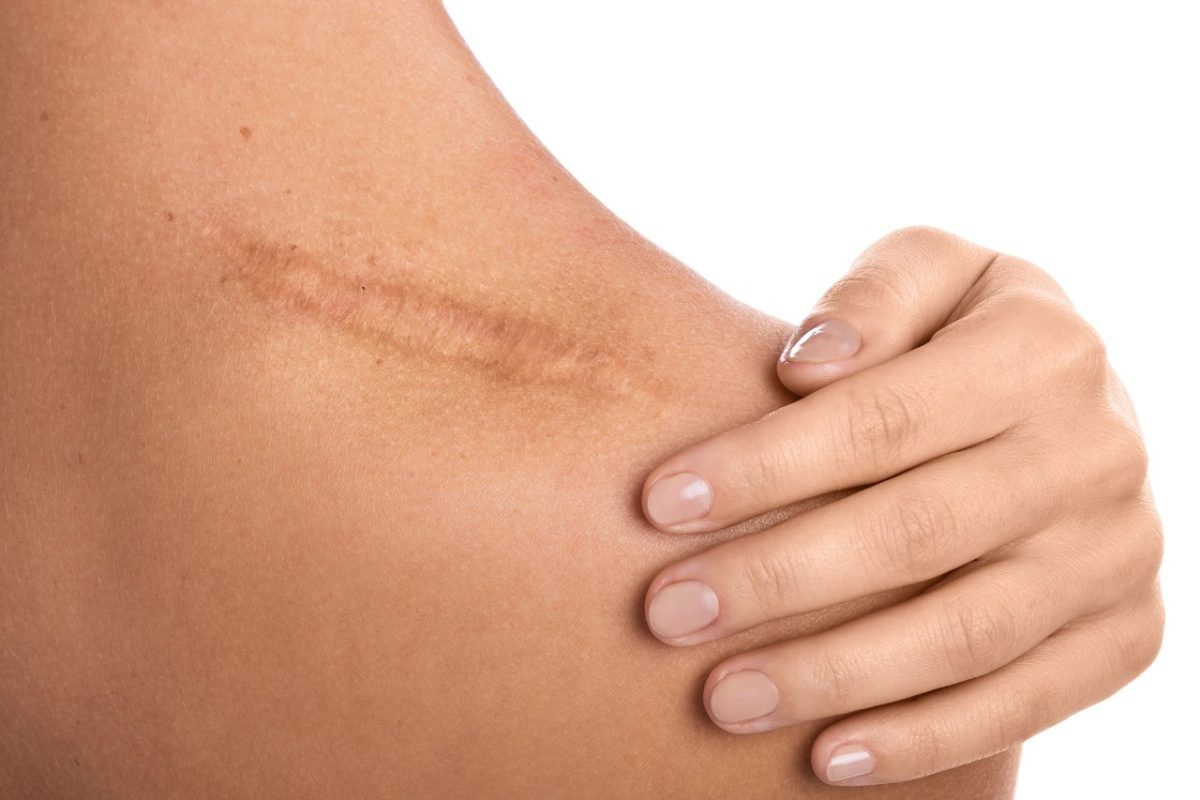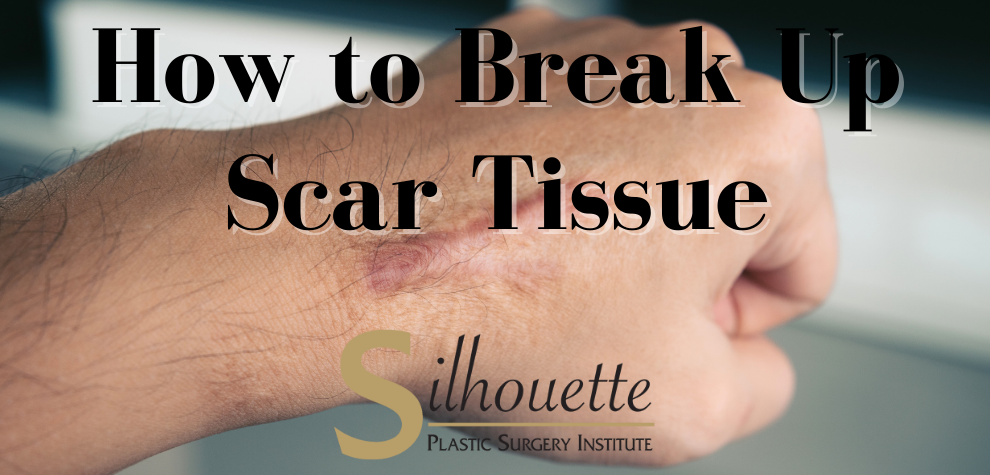After getting plastic surgery in Orange County, it’s highly possible that you’ll find that scar tissue develops. Unfortunately, it is a natural process of the body’s healing, but many patients want to lessen its appearance as much as possible. Scar formation can even feel uncomfortable or tight, causing pain. Luckily, there are techniques that healthcare professionals employ to break up scar tissue. For more information about scar management, scar tissue massage, manual therapy techniques, or revision surgery, contact Silhouette Plastic Surgery Institute today. Call 312-321-1111 or fill out our online intake form.
What Is Scar Tissue?

When someone suffers a serious injury or undergoes surgery, their body responds to the trauma by forming scar tissue. Scar tissue is actually a layer of cells and collagen fibers that forms over the site of an injury. It can even form as a response to serious acne or form around the heart muscle after a heart attack. Scar tissue typically shows itself in one of the following forms.
- Keloid: These are raised, reddish-colored scar tissue plaque. It usually develops on tissues around the upper chest, upper back, and shoulders.
- Hypertrophic Scar: This is one of the more common forms of scar tissue. Many patients with hypertrophic scars notice that the scarred area tends to fade with time.
- Contracture Scar: These are more common after burn injuries. They can sometimes impede movement around the affected area.
Is Scar Tissue Permanent?
Scar tissue does not remain in the body indefinitely. The scar must remodel when it develops and heals. This modification is required so that the new tissue can withstand the stress and pressures that the body encounters on a daily basis.
What Is Remodeling of the Skin?
When you stretch and tug on the region, it begins to reconstruct. The collagen is able to line up and begin to recover as a result of this stretching. Remodeling is necessary to restore full range of motion, strength, and mobility to your wounded tissue. Failure to properly rebuild scar tissue can result in joint contractures.
How Long Does the Remodeling Process Take?
Everyone is unique and recovers at their own pace. In most cases, it takes six to eight weeks for wounded tissue to completely heal. Just keep in mind to take it slowly.
What Causes Scar Tissue?
Although physicians are unknown what causes scar tissue to grow, they do know that burns, bug bites, acne, chickenpox, piercings, tattoos, and surgery can create hypertrophic scars and keloids. Keloids are also more common in those with darker skin, according to research.
Keloids and hypertrophic scars are more common in persons between the ages of 10 and 30 years old. The most crucial rule to follow when it comes to scarring is to avoid it. When feasible, those with risk factors for atypical scarring should avoid elective surgery and address disorders that might lead to scarring, like acne.
Itching and soreness at the scar’s placement are possible side effects. Other scars might make it difficult to move. The look of scars can cause emotional and psychological anguish in certain people. Doctors can prescribe therapies to minimize scarring’s look, but they must also treat the psychological and physical limitations that a scar might impose.
Symptoms of Scar Tissue Pain
For many people, scar tissue is completely painless. Scar tissue that has developed on the skin tends to have a thicker texture than other soft tissue or connective tissue. For other people, however, the developed scar tissue can cause pain. Symptoms of scar tissue pain include the following.
- Swelling or inflammation
- Itching
- Redness
- Sensitivity to touch, pressure, or sensations
- Throbbing
- Creaking joints or muscles
- Reduction in range of motion
Scar Tissue Management Techniques
Your physical therapist may conduct a scar massage on the wounded tissue to aid in the rebuilding process if you have formed scar tissue as a result of an injury or surgery. They may also show you or a close relative how to appropriately massage scar tissue.
Furthermore, kneading an unhealed scar may cause it to open, allowing germs and illness to enter your body. That is not a good thing. To begin scar massage, the scar should be fully healed and free of scabbing. Before beginning scar massage, your healthcare physician and physical therapist should analyze your scar.
Physical Therapy
Physical therapy can help break up scar tissue that has formed around a joint. Learning flexibility exercises and stretches can help to reduce stiffness and relieve some of the discomforts that scarring can bring. This is also a good approach to learn and practice appropriate techniques for specific exercises, which will help you avoid future damage and the formation of more fibrous tissue.
Lubrication
During a scar massage, physical therapists often use a little quantity of lubricants such as baby oil, lotion, or vitamin E oil. After a scar tissue massage, lubrication keeps the scar and skin pliable and supple.
Cross Friction Massage

Cross friction or transverse friction massage is an excellent scar massage technique. This treatment entails massaging the scar line with one or two fingers. This approach aids in the scar’s remodeling. It also guarantees that the scar’s collagen strands are properly positioned. Cross friction massage is often used by physical therapists to address the following conditions.
- Muscle spasms
- Tendonitis
- Sprained ligaments
Myofascial Release
Scar tissue and lesions that may follow it are managed with myofascial release. The procedure is massaging the skin and underlying tissues surrounding the scar with the hands. The movements are gradual and the pressure is typically modest. Your physical therapist can feel for fascia, or tissue limitations, in several directions. They can then focus on improving their mobility in those confined areas.
Instrument Assisted Scar Tissue Massage
Instrument-assisted soft tissue mobilization is a relatively recent physical therapy practice. Specialized stainless steel implements of varying shapes and sizes are used to massage and manipulate muscles in this method. Your physical therapist may use this approach to break up your scar tissue by massaging it with an instrument. The usage of IASTM is relatively new. As a result, a thorough scientific investigation is needed to evaluate whether it is advantageous.
Stretching
Stretching and flexibility exercises are other common ways to help scar tissue repair. It can aid in the lengthening of wounded tissues as well as their general mobility. Your physical therapist is likely to include scar massage and stretches in your rehabilitation regimen if you’ve had an accident or surgery. Scar tissue stretching may be an important part of your healing. Most specialists believe that stretching with a low load for a long time is important to properly reconstruct scar tissue.
Laser Therapy
Laser therapy is a type of treatment that moves beyond the skin and encourages the healthy production of collagen cells. This therapy procedure is unlikely to entirely remove scarred tissue, but it can be a useful tool for reducing mild irritation, discomfort, and improving mobility.
Corticosteroid Injections
Corticosteroid injections have been demonstrated to help relieve pain caused by tissue scarring. Steroid injections are a strong anti-inflammatory, but the drawback is that they can harm adjacent, healthy tissue, perhaps leading to more injury. While some people react to steroid injections straight away, others require many administrations over a few weeks, increasing the risk of harming good tissue.
Shockwave Therapy
ESWT, or extracorporeal shockwave treatment, transmits impulse pressure waves deep into wounded and scarred tissue to break apart damaged tissue at the cellular level. Shockwave treatment uses pressure waves to enhance blood flow and the creation of new blood vessels in the damaged region, allowing for faster healing than conventional procedures.
Unlike other forms of scar tissue treatment, this is a non-invasive method with little to no danger of infections or recovery time. It is a form of treatment that helps with pain or scarring from surgeries.
Scar and Skin Removal Surgery
Scar tissue discomfort on injuries or difficulties when the scarred region is deep and extensive is usually treated with surgery as a last option. During this procedure, doctors attempt to remove diseased tissue or conduct skin grafts by grafting healthy skin from another portion of the body.
Surgery comes with its own set of hazards, as well as a lengthy recovery period. As a result, every result should be properly addressed with your doctor. While some scar tissue may appear to be nothing more than an unsightly skin disease, others have underlying scarring damage that causes discomfort or limits movement and overall sports performance. If left untreated, damaged tissue can lead to more serious issues.
Scar Tissue Management After a Fracture
Callus refers to the scar tissue that forms on the surface of the bone. It lasts four to twelve weeks following a fracture. Your physical therapist may massage the overlying tissue surrounding the callus if you’ve fractured a bone and begun physical therapy. This approach aids in the restoration of normal movement. Scar massage over your scar may also help if you’ve had surgery to mend your fractured bone. Speak with a trusted healthcare provider about your options.
Does Scar Tissue Massage Really Work?
The efficacy of massaging scar tissue is hotly debated, but many people see success with it. Many patients claim that it helps them in the following ways.
- Promoting healthy tissue growth of collagen cells, fibrous tissue, and other new cells
- Increase blood flow
- Improve movement and normal mobility
- Reducing pain
- Promote strength
- Reduce inflammation in the healthy tissue, injured tissues, tendons, and joints
How Long Does It Take to Break Up Internal Scar Tissue?
For a variety of causes, scar tissue can accumulate over time. Sprains, strains, overuse, damage, surgery, or just prolonged everyday activity are examples of these injuries. Scar development is most frequent in joints, tendons, muscles, and soft tissues, and it causes stiffness, discomfort, and pain. Once the scar tissue congestion is cleared, you’ll find that the stiffness and soreness you were experiencing will go away. More mobility will be possible as a result of this.
There are several stretches and exercises that may be done to assist with the soft tissue rehabilitation procedure. A physical therapist can be really beneficial in this situation. Physical therapists will develop a home-based manual treatment, exercise, and stretching program for you. Depending on your specific case, the amount of time it takes to treat scar tissue varies greatly.
Can Deep Scar Tissue Be Removed?
Depending on your situation, there are a variety of alternatives for treating deeper scars. Skin grafts, excision, dermabrasion, and laser surgery are some of the options. The surgeon utilizes skin from another part of your body in a skin graft. This is a common treatment for burn victims. If you have scarring that is interfering with your ability to function, surgery may be able to assist. If you’ve just undergone surgery that left you with scars, you should wait at least a year before deciding on scar therapy. Over time, many scars heal and become less apparent.
Contact an Orange County Plastic Surgeon Today
After a cosmetic surgery scar starts to form, you’ll likely start looking for someone to perform scar tissue massage. Physical therapy is a great option, and there is a wide variety of massage techniques to choose from. Speak with your Orange County plastic surgeon about when it’s safe to try manual therapy. Dr. Daneshmand will walk you through the entire recovery process. To schedule an appointment with us, please contact Silhouette Plastic Surgery Institute at 949-359-8397. You can also fill out our online intake form.

